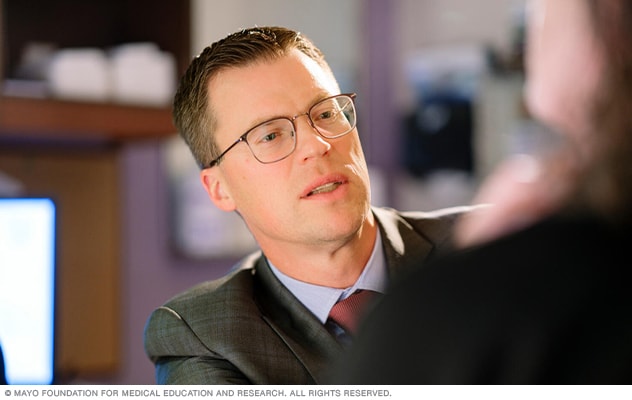التشخيص
لتشخيص رتج زنكر، يُجري اختصاصي الرعاية الصحية، الذي غالبًا ما يكون اختصاصي الأذن والأنف والحنجرة (ENT)، فحصًا بدنيًا ويسأل عن الأعراض.
 فحص أحد الأشخاص
فحص أحد الأشخاص
اختصاصي رعاية صحية في مايو كلينك يفحص أحد الأشخاص.
الاختبارات
ابتلاع الباريوم هو أكثر الاختبارات التي تُجرى غالبًا لتشخيص رتج زنكر.
وفي هذا الاختبار، يلتقط الاختصاصي سلسلة من صور الأشعة السينية للسبيل الهضمي بعدما يبتلع المريض سائلاً يُغلِّف جدران السبيل الهضمي.
يساعد السائل، المسمى سلفات الباريوم، على سهولة رؤية السبيل الهضمي في صور الأشعة السينية.
العلاج
لعلاج رتج زنكر، قد يلزم التدخل الجراحي أو غيره من الإجراءات.
وقد يساعد تناول الأطعمة الأكثر ليونة على قضمات صغيرة على البلع إذا كانت لديك أعراض خفيفة من رتج زنكر.
وقد يقترح اختصاصي الرعاية الصحية زيارةَ اختصاصي نُظم غذائية لمساعدتك على معرفة الطعام المناسب لك.
أنواع العمليات الجراحية أو الإجراءات الأخرى
ترميم المريء بإجراء أو جراحة هو العلاج الأكثر شيوعًا لرتج زنكر الذي يسبب ظهور أعراض.
وغالبًا ينفِّذ الإجراءَ أو الجراحة اختصاصيون في علاج أمراض الأذن والأنف والحنجرة.
وغالبًا ما ينفذون الإجراء عن طريق أنبوب يسمى المنظار الداخلي يصل إلى المريء عبر الفم.
وهذا الإجراء أقل توغلاً من الجراحة المفتوحة.
تتطلب إجراءات التنظير الداخلي لعلاج رتج زنكر، تسمى أحيانًا علاجات بالتنظير الداخلي، أوقات جراحة أقصر في أغلب الأحيان وقد تكون مدة الإقامة في المستشفى أقصر مقارنةً بالجراحة المفتوحة.
كما أنها تُخفِّف أعراض رتج زنكر لدى المرضى وغالبًا ما تكون نتائجها مشابهة لنتائج الجراحة المفتوحة.
لكن الأشخاص الذين يخضعون لإجراءات التنظير الداخلي قد يكونون عرضة بشكل أكبر لخطر تكرار الإصابة برتج زنكر.
يوجد نوعان أساسيان من التنظير الداخلي يُستخدمان لعلاج رتج زنكر.
ويستغرق إجراء كل منهما من ساعة إلى ساعتين تقريبًا.
-
التنظير الداخلي بالمنظار الصلب.
قبل الخضوع لهذا الإجراء الجراحي، ستتلقى دواءً يسمى مخدرًا عامًّا يُدخلك في حالة شبيهة بالنوم.
وسيستخدم اختصاصي الأذن والأنف والحنجرة منظارًا داخليًا صلبًا للوصول إلى المريء.
وهذا المنظار الداخلي الصلب لا ينثني أو يلتوي.
وكثيرًا ما يستخدم اختصاصي الأذن والأنف والحنجرة الليزر أو قد يستخدم دباسة لتوسيع فتحة الوصول إلى الكيس.
في بعض الأحيان، يمكن أن يستأصل اختصاصيُّ الأذن والأنف والحنجرة الكيسَ باستخدام جهاز الليزر.
وهذا الإجراء يسمى استئصال الرتج بالتنظير الداخلي.
والكاوي الكهربائي خيار متاح أيضًا، لكنه نادرًا ما يُستخدم مع التنظير الداخلي بالمنظار الصلب.
-
التنظير الداخلي بالمنظار المَرِن.
قبل الخضوع لهذا الإجراء الجراحي، قد تتلقى دواءً يسبب الدخول في حالة شبيهة بالنوم تقريبًا، ويُعرف هذا بالتسكين العميق، أو التخدير العام.
ويكون المنظار الداخلي مرنًا.
ويستخدم الجرّاح جهازًا يعمل بالتيار الكهربائي، يسمى الكاوي الكهربائي، لاستئصال الكيس.
وقد تُستخدم المشابك لوقف أي نزيف.
قد يلزم في بعض الأحيان علاج رتج زنكر من خلال الجراحة المفتوحة.
وستخضع للتخدير العام قبل الإجراء الجراحي.
وسيُحدِث اختصاصي الأذن والأنف والحنجرة قطعًا، يسمى شقًا، في الرقبة لإزالة الكيس.
غالبًا ما تستغرق هذه العملية الجراحية من ساعتين إلى ثلاث ساعات.
وغالبًا ما يبقى الأشخاص الذين يخضعون لها يومًا أو أكثر في المستشفى.
وتُخفِّف هذه الجراحة الأعراض لدى أغلب الأشخاص.
المضاعفات المحتملة
قد تشمل مضاعفات الجراحة التي تُجرى لعلاج رتج زنكر ما يأتي:
- العَدوى.
- الجلطات الدموية.
- التفاعلات الناجمة عن التخدير.
- انثقاب المريء.
- إصابة الأسنان، كأن تُكسر سن عند إجراء الجراحة باستخدام المنظار الداخلي.
النتائج
تساعد كل من الجراحة بالتنظير الداخلي والجراحة المفتوحة على تخفيف أعراض رتج زنكر لدى معظم الأشخاص.
لكن إجراءات التنظير الداخلي غالبًا ما تستغرق وقتًا أقصر في الجراحة.
أما فترة الإقامة في المستشفى فغالبًا ما تكون ليلة واحدة لإجراءات التنظير الداخلي والجراحات المفتوحة.
تترك الجراحة المفتوحة ندبة صغيرة في الرقبة.
ويمكن أيضًا أن تنطوي الجراحة المفتوحة على خطر أكبر لإحداث ثقب في المريء مقارنةً بتقنيات التنظير الداخلي.
وفي الحالات التي يكون فيها رتج زنكر كبيرًا، قد تكون الجراحة المفتوحة الخيار الأفضل لاستئصال الكيس تمامًا.
وإذا لم يخفف الإجراء الأول الأعراض أو في حال عودة رتج زنكر، فقد تحتاج إلى الخضوع لإجراء آخر.
وإذا عاد رتج زنكر من جديد، فغالبًا لا تصاحبه أي أعراض.
ويدرس الباحثون طرقًا جديدة لعلاج هذه الحالة المرضية.
التجارب السريرية
استكشِف دراسات مايو كلينك حول التطورات الجديدة في مجال العلاجات والتدخلات الطبية والاختبارات المستخدمة للوقاية من هذه الحالة الصحية وعلاجها وإدارتها.
الاستعداد لموعدك
إذا كنت تجد صعوبة في البلع أو غير ذلك من أعراض رتج زنكر، فاحجز موعدًا طبيًا مع اختصاصي الرعاية الصحية الأولية.
وقد تحال إلى اختصاصي في أمراض الأذن والأنف والحنجرة.
إليك بعض المعلومات التي تساعدك على الاستعداد للموعد الطبي.
ما يمكنك فعله
عند حجز الموعد الطبي، اسأل عما إذا كانت هناك أمور يتعين عليك فعلها قبل الموعد، مثل الصيام قبل إجراء فحص معين.
جهّز قائمة بما يلي:
-
الأعراض التي تشعر بها، بما في ذلك أي أعراض قد تبدو غير مرتبطة بسبب حجز الموعد الطبي، ووقت بداية ظهورها.
-
المعلومات الشخصية الأساسية، بما فيها عوامل التوتر الشديد والتغيرات الحياتية التي حدثت مؤخرًا والسيرة المَرضية للعائلة.
-
جميع الأدوية أو الفيتامينات أو المكملات الغذائية الأخرى التي تتناولها، مع ذِكر الجرعات.
-
الأسئلة التي تريد طرحها على اختصاصي الرعاية الصحية.
اصطحب معك أحد أفراد العائلة أو الأصدقاء، إن أمكن، لمساعدتك على تذكُّر المعلومات التي يقدمها إليك الطبيب.
بالنسبة إلى رتج زنكر، تتضمن الأسئلة الأساسية التي يمكن طرحها ما يأتي:
- ما السبب المرجح للأعراض التي أشعر بها؟
- ما الاختبارات التي أحتاج إلى إجرائها؟
- هل من المُرجح أن أتماثل للشفاء من هذه الحالة المرضية أم أنها ستكون طويلة المدى؟
- ما أفضل إجراء يمكن اتخاذه؟
- لديَّ مشكلات صحية أخرى.
كيف يمكنني إدارة هذه المشكلات معًا على أفضل نحو؟
- هل هناك قيود ينبغي لي الالتزام بها؟
- هل يجب أن أراجع اختصاصيًا؟
- هل هناك أي كتيبات أو مطبوعات أخرى يمكنني الحصول عليها؟
ما المواقع الإلكترونية التي توصيني بزيارتها؟
احرص على طرح كل الأسئلة التي تدور في ذهنك.
ما تتوقعه من الطبيب
من المحتمل أن يطرح عليك اختصاصي الرعاية الصحية أسئلة مثل:
- هل الأعراض مستمرة، أم أنها تظهر وتختفي؟
- ما مدى شدة الأعراض؟
- ما الذي يؤدي إلى تحسن الأعراض، إن وُجد؟
- ما الذي يبدو أنه يسبب تفاقم الأعراض، إن وُجد؟
ما الذي يمكنك القيام به في هذه الأثناء
إذا كنت تجد صعوبة في البلع، فجرِّب تناول أطعمة أكثر ليونة بقضمات أصغر.